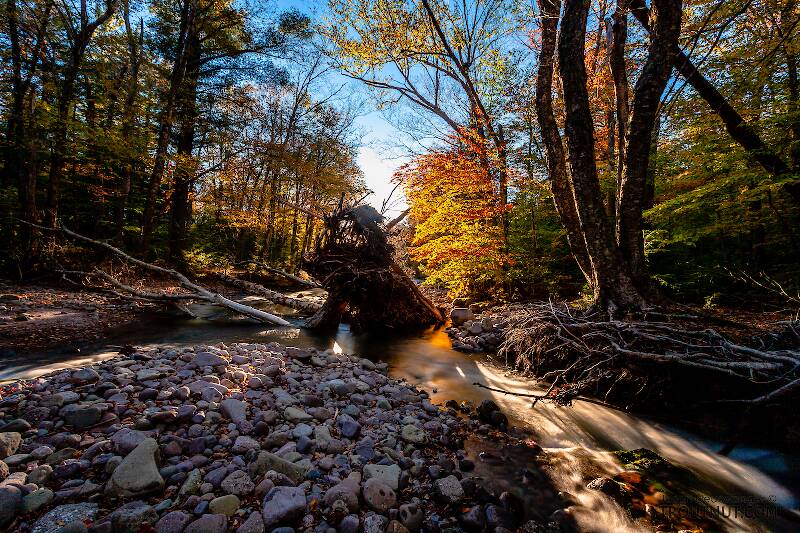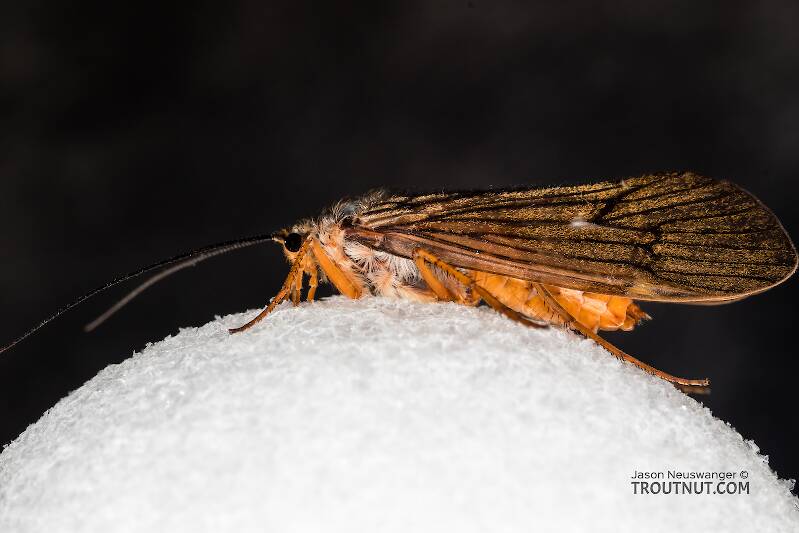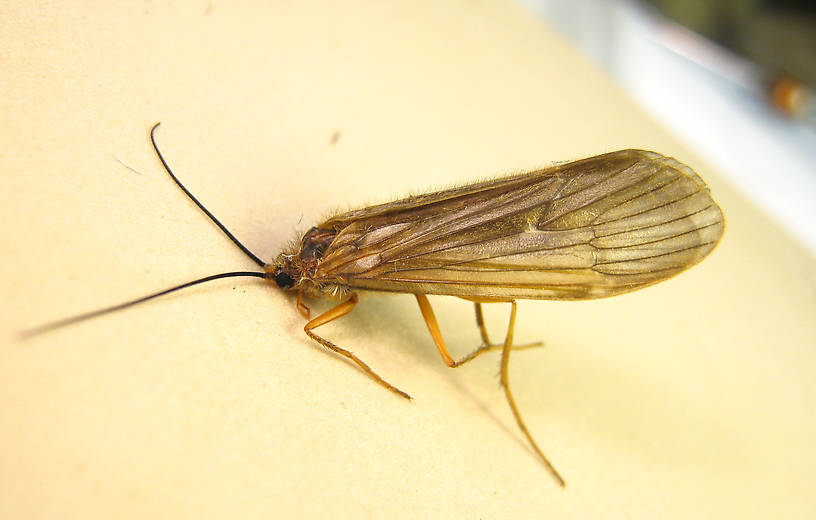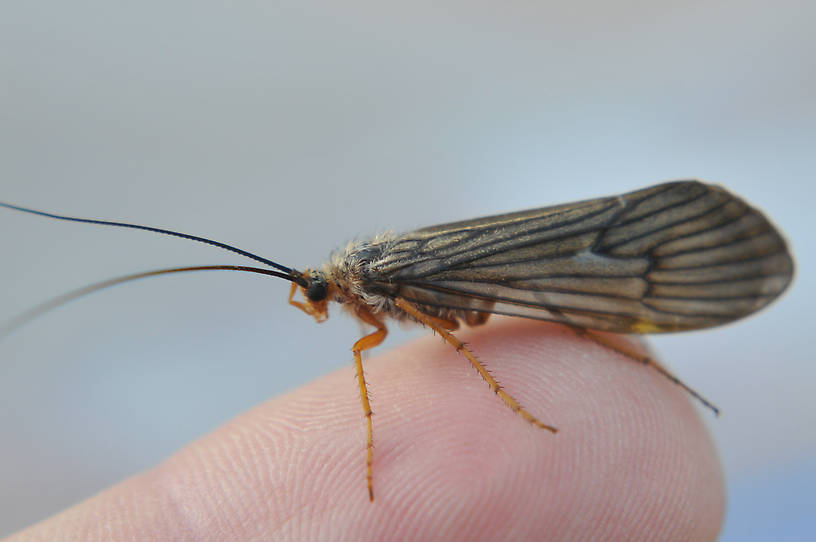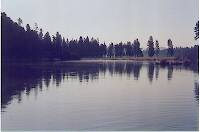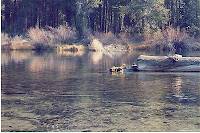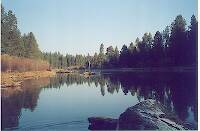
Blue-winged Olives
Baetis
Tiny Baetis mayflies are perhaps the most commonly encountered and imitated by anglers on all American trout streams due to their great abundance, widespread distribution, and trout-friendly emergence habits.
Featured on the forum

Troutnut is a project started in 2003 by salmonid ecologist Jason "Troutnut" Neuswanger to help anglers and
fly tyers unabashedly embrace the entomological side of the sport. Learn more about Troutnut or
support the project for an enhanced experience here.
This topic is about the Caddisfly Genus Dicosmoecus
This is a superhatch in the West. Gary LaFontaine had a self-proclaimed obsession with Dicosmoecus, and he devotes several pages of Caddisflies to stressing the importance of its larvae, pupae, and adults. He wrote:The question for fly fishermen seeking big trout is: "Which insects provide the best opportunity for catching such fish?" My list would be: Giant Orange Sedge (Dicosmoecus sp.), Salmon Fly (Pteronarcys californica, a stonefly), and the Michigan Mayfly (Hexagenia limbata). Dicosmoecus is the most important -- and the contest is not even close.
His reasons for this judgement are five traits of Dicosmoecus:
- Very large size: Adults 30mm long, and thick.
- Activity concentrated within 2-3 weeks.
- Emerges in the low, clear water of fall.
- Active during afternoon and evening.
- Abundant in rivers with sea-run trout.
Personally I have only caught a good Dicosmoecus hatch one time, and on a secret desert spring creek. It reminded me of fishing Isonychia mayfly hatches back east, because there weren't enough bugs around to have trout rising consistently, but the presence of a particularly good food source in low numbers for a long time had them on the lookout for imitations. I had big trout cartwheeling out of the water to smash actively-fished imitations.
Example specimens
Troutnut on Jul 29, 2006July 29th, 2006, 9:21 am EDT
This seems to be a very important insect for which I have no experience and few sources. I want to be sure that my writeup is accurate and fairly complete. Do any of you who fish out west know any details I've left out?
Jason Neuswanger, Ph.D.
Troutnut and salmonid ecologist
Troutnut and salmonid ecologist
Upnorth2 on Aug 18, 2006August 18th, 2006, 3:22 pm EDT
Reads about right.
Dano on Oct 12, 2007October 12th, 2007, 4:17 am EDT
Jason,
Just found your site....
In my neck o' the woods (Klamath Falls, Or.) the Fall Caddis, Limnephilidae dicosmoecus, is referred to as either the October Caddis or Orange Caddis. I recall that Schollmeyer lists it's size as 20-30mm. My "home stream" is the Williamson River and my adult specimans range between 20-22mm. Further, the hatch begins in earnest around the last week in September through October. I've also been able to determine that stream temperature, rather than time of day, is what triggers the emergance. On the stretch that I generally fish, this is when the temp rises to 40º, the emergance peaks at 42º, and stops altogether above 43º. On the Williamson, at least, this is generally about an hour and a half after the official sunrise and 2 hours before sunset, depending on the amount of cloud cover.
They do head for "shore" into tall grass and I've had specimans live for as long as 14 days.
I don't feel that my data for the Deschutes, Umpqua, and Rogue to be complete. However, I suspect that when water temps are within a few degrees of their averages, the emergance begins/ends.
I should probably stress that actual colors will vary from not only stream to stream but by "sections" as well. Generally, the body is greyish/orange and the wing a medium to dark ginger. I've found that as a "searching" pattern, during this emergance that a Large Ginger Fluttering Caddis (Orvis) on a 10-12 to be effective, an Elk Hair Caddis with Adams Grey/Orange body and dark Elk Hair (10-12) for the wing will do in a pinch. Personally, I use a design of my own making based upon the specimans I've captured. The important thing, IMHO, is that the wing be twice the length of the body and tied tentwing or downwing style.
I've experimented considerbly with patterns having translucent dubbing to imitate the shuck, my experience is that the "standard" dry patterns work best; fished wet or dry, with some movement. My observations are that because these flies emerge so quickly, particularly in deeper runs where there are outcropings or snags, that your "big ones" station themselves in a feeding lane and slurp...No splashy rises here. Tied with a small burnt orange/pale yellow egg sac at the tail and the wings slightly splayed and down is deadly....
That this is a significant hatch, would be an understatement and I agree entirely with LaFontaine's assesment. Hope this helps and I apologize for the length...
Dano
Edit in: BTW, I'm a transplanted Michigander and was astounded to find that the Williamson has, in fact, a Hex hatch that rivals those I fished on the Au Sable....
Just found your site....
In my neck o' the woods (Klamath Falls, Or.) the Fall Caddis, Limnephilidae dicosmoecus, is referred to as either the October Caddis or Orange Caddis. I recall that Schollmeyer lists it's size as 20-30mm. My "home stream" is the Williamson River and my adult specimans range between 20-22mm. Further, the hatch begins in earnest around the last week in September through October. I've also been able to determine that stream temperature, rather than time of day, is what triggers the emergance. On the stretch that I generally fish, this is when the temp rises to 40º, the emergance peaks at 42º, and stops altogether above 43º. On the Williamson, at least, this is generally about an hour and a half after the official sunrise and 2 hours before sunset, depending on the amount of cloud cover.
They do head for "shore" into tall grass and I've had specimans live for as long as 14 days.
I don't feel that my data for the Deschutes, Umpqua, and Rogue to be complete. However, I suspect that when water temps are within a few degrees of their averages, the emergance begins/ends.
I should probably stress that actual colors will vary from not only stream to stream but by "sections" as well. Generally, the body is greyish/orange and the wing a medium to dark ginger. I've found that as a "searching" pattern, during this emergance that a Large Ginger Fluttering Caddis (Orvis) on a 10-12 to be effective, an Elk Hair Caddis with Adams Grey/Orange body and dark Elk Hair (10-12) for the wing will do in a pinch. Personally, I use a design of my own making based upon the specimans I've captured. The important thing, IMHO, is that the wing be twice the length of the body and tied tentwing or downwing style.
I've experimented considerbly with patterns having translucent dubbing to imitate the shuck, my experience is that the "standard" dry patterns work best; fished wet or dry, with some movement. My observations are that because these flies emerge so quickly, particularly in deeper runs where there are outcropings or snags, that your "big ones" station themselves in a feeding lane and slurp...No splashy rises here. Tied with a small burnt orange/pale yellow egg sac at the tail and the wings slightly splayed and down is deadly....
That this is a significant hatch, would be an understatement and I agree entirely with LaFontaine's assesment. Hope this helps and I apologize for the length...
Dano
Edit in: BTW, I'm a transplanted Michigander and was astounded to find that the Williamson has, in fact, a Hex hatch that rivals those I fished on the Au Sable....
Troutnut on Oct 12, 2007October 12th, 2007, 1:24 pm EDT
No need to apologize for the length, Dano. That's just the kind of information-packed post I want to encourage!
Jason Neuswanger, Ph.D.
Troutnut and salmonid ecologist
Troutnut and salmonid ecologist
Dano on Oct 12, 2007October 12th, 2007, 3:07 pm EDT
Jason,
Thanks; this was my first post here and didn't want to step on anybody's toes....
I should clarify something though. As I said, on the Williamson the Fall Caddis (L. dicosmoecus), ranges between 20-22mm (#12) thus, it's not a "greater" hatch than the Salmon Fly (P. califonica), Hex (H. limbata) or even the Brown Drake (E. stimulans), IMHO. Currently my data for the previously mentioned rivers reveals them to be closer to a #10 (22-24mm). But it is significant, regardless, as Lafontaine suggests.
I know your question was aimed at "Orange Sedge" users, and I have experimented some with sedge patterns. For me, at least, I don't find them effective and consider those experiments "concluded"; you won't find a single sedge pattern in my boxes...
I've just completed a seven year study of Mayfly hatches specific to the Klamath Basin and am about a year away from completing my chart on Caddis and Stoneflies for the same region. So I feel fairly versed on those topics. If you have more specific questions in regard to the Fall Caddis, I'll do my best to answer them.
My question is: What do you consider to be "shallow water"? The reason I ask is that if one overlooks 4' and deeper "holes" during emergance chances of them gettin' into a "biggie" is slim to none...
Dano
Thanks; this was my first post here and didn't want to step on anybody's toes....
I should clarify something though. As I said, on the Williamson the Fall Caddis (L. dicosmoecus), ranges between 20-22mm (#12) thus, it's not a "greater" hatch than the Salmon Fly (P. califonica), Hex (H. limbata) or even the Brown Drake (E. stimulans), IMHO. Currently my data for the previously mentioned rivers reveals them to be closer to a #10 (22-24mm). But it is significant, regardless, as Lafontaine suggests.
I know your question was aimed at "Orange Sedge" users, and I have experimented some with sedge patterns. For me, at least, I don't find them effective and consider those experiments "concluded"; you won't find a single sedge pattern in my boxes...
I've just completed a seven year study of Mayfly hatches specific to the Klamath Basin and am about a year away from completing my chart on Caddis and Stoneflies for the same region. So I feel fairly versed on those topics. If you have more specific questions in regard to the Fall Caddis, I'll do my best to answer them.
My question is: What do you consider to be "shallow water"? The reason I ask is that if one overlooks 4' and deeper "holes" during emergance chances of them gettin' into a "biggie" is slim to none...
Dano
Troutnut on Oct 12, 2007October 12th, 2007, 5:32 pm EDT
I know your question was aimed at "Orange Sedge" users,
I wasn't actually trying to limit the question to a specific pattern. I was talking about Dicosmoecus in general. I just try to use widely accepted common names so more people follow what I'm asking about sometimes.
When I wrote that their emergence habitat is shallow water, I got that from 'Caddisflies' and 'Selective Trout.' Neither source was more specific than that. Since I haven't fished a Dicosmoecus hatch myself, I don't have much to add... which is why it's great to have guys like you pitching in.
Jason Neuswanger, Ph.D.
Troutnut and salmonid ecologist
Troutnut and salmonid ecologist
Dano on Oct 12, 2007October 12th, 2007, 6:57 pm EDT
I see...
I have the 8th printing (March '73) of Selective Trout and can't find any reference to water depth or speed in their brief discussion on Caddis flies...I used to fish the rivers on a regular basis that they mention; the Muskegon is most definetly a "deep" river.
Any who, when I was back in Michigan I didn't pay much attention to Caddis flies. I only carried a couple of patterns; Elk Hair Caddis in olive and tan 12-16s and Small Fluttering Caddis (Orvis). From the last weekend in August through the winter I concentrated on hunting Salmon and Steelhead. Hadn't even heard of a Fall Caddis or Orange Caddis (whatever) until I moved out here.
Because of the severe decline of Salmon/Steelhead runs here, I no longer hunt 'em and found myself running into this hatch fishing for Browns and Rainbows, which prompted a more indepth study of this order. Nonetheless, as Swisher and Richards pointed out way back when, caddis flies are an important food source...
I feel blessed in the sense that the Williamson is a very rich environment where multiple hatches at the same time (as many as 8) are the rule not the exception. So the "task" isn't as daunting as it may appear, the long length of time is only to average out the time of year any particular hatch occurs...
My guess as to why there is so little written about this particular hatch is because it occurs at the same time the Steelhead are running, so most concentrate their efforts flogging the waters for them. The Williamson empties into Upper Klamath Lake and the 'Bows do run up it to spawn, starting about mid September. No Steelhead, though.
Dano
I have the 8th printing (March '73) of Selective Trout and can't find any reference to water depth or speed in their brief discussion on Caddis flies...I used to fish the rivers on a regular basis that they mention; the Muskegon is most definetly a "deep" river.
Any who, when I was back in Michigan I didn't pay much attention to Caddis flies. I only carried a couple of patterns; Elk Hair Caddis in olive and tan 12-16s and Small Fluttering Caddis (Orvis). From the last weekend in August through the winter I concentrated on hunting Salmon and Steelhead. Hadn't even heard of a Fall Caddis or Orange Caddis (whatever) until I moved out here.
Because of the severe decline of Salmon/Steelhead runs here, I no longer hunt 'em and found myself running into this hatch fishing for Browns and Rainbows, which prompted a more indepth study of this order. Nonetheless, as Swisher and Richards pointed out way back when, caddis flies are an important food source...
I feel blessed in the sense that the Williamson is a very rich environment where multiple hatches at the same time (as many as 8) are the rule not the exception. So the "task" isn't as daunting as it may appear, the long length of time is only to average out the time of year any particular hatch occurs...
My guess as to why there is so little written about this particular hatch is because it occurs at the same time the Steelhead are running, so most concentrate their efforts flogging the waters for them. The Williamson empties into Upper Klamath Lake and the 'Bows do run up it to spawn, starting about mid September. No Steelhead, though.
Dano
Dgracia
Posts: 3
Posts: 3
Dgracia on Jan 7, 2009January 7th, 2009, 10:09 am EST
Hi Jason,
I have a LOT of experience with the Dicosmoecus hatch in Northern California. It's called the October Caddis there, though sometimes it emerges in September.
I find it really strange to see comments that the pupa is not important. In my experience the pupa far outfishes the dry fly, at least on the McCloud River and the Upper Sacramento River. I coordinated and taught the Orvis West Coast Fly-Fishing Schools along with Dean Schubert from 1987 through 1997. I was also a licensed guide in California through 1998. During those years I averaged about 120-140 days a year on the water - mostly teaching others to fish, but certainly getting in my own licks too. I very often would spend 3 days at a time on the McCloud or Upper Sacramento River in between school dates for Schools we held on Hat Creek and Fall River.
September and October were always a great time to fish the McCloud and Upper Sac specifically because of the October Caddis. I made a point of getting up to there for this hatch. I still go back there annually if I can, even though I now live in Virginia, a mere 3,000 miles away. I've made it back 3 out of the last 4 years just for the October Caddis hatch. It's also a convenient time to get my family and friends together.
You know the fish are on the pupa when you see the cases on top of the rocks instead of under them. When they first appear, a size 8, 3x long pupa imitation works great. A couple of weeks later you'll need a size 6. Yes the cases are on the rocks in the shallows, but they're also on the rocks in 3 to 4 feet of water. I'll fish the pupa dead drift on the bottom and then swing it up at the end of the drift. By far and away, most of the takes are while the fly is dead drifting.
The dry fly doesn't often elicit a lot of response from the trout. Once they start hatching they will be around the river and flying around your lantern for weeks. You'll see them on the water and the trout for the most part ignore them. Evening shadows is about the only time that trout seem to key in on them at all, and even then you'll catch 3 to 4 times as many fish on the nymph as you will on the dry.
The McCloud River has a June hatch of Pteronarcys Princeps which looks like a smaller version of the Pteronarcys Californica. It's two-year bug as opposed to the 3-year giant salmonfly, but basically just looks like a smaller version. Trout are all over the stonefly dry when that hatch is going on, much more so than they are on the Dicosmoecus. So I'm a little surprised at the uproar about the dry fly and denigrating the pupa. In truth, if I was only restricted to fishing the pupa during the October Caddis hatch, I would be perfectly happy. That absolutely is the main fly that I fish during that time.
Thanks,
Dan
I have a LOT of experience with the Dicosmoecus hatch in Northern California. It's called the October Caddis there, though sometimes it emerges in September.
I find it really strange to see comments that the pupa is not important. In my experience the pupa far outfishes the dry fly, at least on the McCloud River and the Upper Sacramento River. I coordinated and taught the Orvis West Coast Fly-Fishing Schools along with Dean Schubert from 1987 through 1997. I was also a licensed guide in California through 1998. During those years I averaged about 120-140 days a year on the water - mostly teaching others to fish, but certainly getting in my own licks too. I very often would spend 3 days at a time on the McCloud or Upper Sacramento River in between school dates for Schools we held on Hat Creek and Fall River.
September and October were always a great time to fish the McCloud and Upper Sac specifically because of the October Caddis. I made a point of getting up to there for this hatch. I still go back there annually if I can, even though I now live in Virginia, a mere 3,000 miles away. I've made it back 3 out of the last 4 years just for the October Caddis hatch. It's also a convenient time to get my family and friends together.
You know the fish are on the pupa when you see the cases on top of the rocks instead of under them. When they first appear, a size 8, 3x long pupa imitation works great. A couple of weeks later you'll need a size 6. Yes the cases are on the rocks in the shallows, but they're also on the rocks in 3 to 4 feet of water. I'll fish the pupa dead drift on the bottom and then swing it up at the end of the drift. By far and away, most of the takes are while the fly is dead drifting.
The dry fly doesn't often elicit a lot of response from the trout. Once they start hatching they will be around the river and flying around your lantern for weeks. You'll see them on the water and the trout for the most part ignore them. Evening shadows is about the only time that trout seem to key in on them at all, and even then you'll catch 3 to 4 times as many fish on the nymph as you will on the dry.
The McCloud River has a June hatch of Pteronarcys Princeps which looks like a smaller version of the Pteronarcys Californica. It's two-year bug as opposed to the 3-year giant salmonfly, but basically just looks like a smaller version. Trout are all over the stonefly dry when that hatch is going on, much more so than they are on the Dicosmoecus. So I'm a little surprised at the uproar about the dry fly and denigrating the pupa. In truth, if I was only restricted to fishing the pupa during the October Caddis hatch, I would be perfectly happy. That absolutely is the main fly that I fish during that time.
Thanks,
Dan
Quick Reply
Related Discussions
Topic
Replies
Last Reply
2
Sep 20, 2020
by Creno
by Creno
19
Oct 24, 2008
by Jack_k
by Jack_k
10
Dec 21, 2007
by Creno
by Creno
14
Sep 26, 2013
by Crepuscular
by Crepuscular

